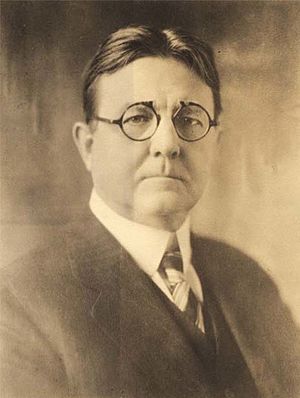Abraham Cressy Morrison facts for kids
Abraham Cressy Morrison (born December 6, 1864 – died January 9, 1951) was an American chemist. He was also the president of the New York Academy of Sciences.
Contents
About Abraham Cressy Morrison
Abraham Cressy Morrison was born in Wrentham, Massachusetts, on December 6, 1864. His sister was the writer, Cora Linn Daniels.
He traveled a lot with his parents when he was young. At age 13, he had to start working to help his family. He tried many different jobs, from selling goods to working in a hotel. This early experience helped him learn about advertising.
When he was 23, he got a job at Pabst Brewing Co. There, he became in charge of advertising. He worked for Pabst Brewery from 1895 to 1897. He mainly helped market their 'Malt Tonic'.
A Passion for Bicycling
Morrison loved bicycling! He was known as a 'wheelman'. He became an important leader in the League of American Wheelmen. He was president of the Milwaukee Wheelmen and later a vice president in the national group.
He even raced long distances and won prizes in 100-mile contests. He lived in Milwaukee and had a small house in Whitefish Bay. The bike ride from Milwaukee to Whitefish Bay was very popular. People said the road was always in great shape and offered good fun along the lake shore.
Morrison also led efforts to make roads better. The governor of Wisconsin even asked him to join a committee to improve roads.
His Writings
While in Milwaukee, Morrison wrote a history of the city. He also wrote about the brewing industry.
He wrote some other books too. One was The Story of Damon and Pythias. This book became the official version for the Knights of Pythias group. Nearly 200,000 copies were sold! He also wrote The Man Who Resembled Christ.
In 1937, Morrison published Man in a Chemical World. This book helped explain science to the public. His biggest work was The Baking Powder Controversy. It was a two-volume book about the history of the baking powder industry in the U.S.
Even though some people called him 'Dr.' or 'Professor', Morrison mostly had a public school education and a year of business college. He was named a 'Fellow' in the New York Academy of Sciences, which is a special honor for respected scientists.
Family Life
Morrison, known as Cressy to his close friends, married Marguerite Snow. She led an organization called American Women Against Communism, which he helped support. They had a summer home on Deer Isle in Maine. There, Morrison enjoyed entertaining guests and fishing. He was also a member of The Chemists' Club of New York.
He passed away on January 9, 1951, at his home in Brooklyn, New York City.
The A. Cressy Morrison Prize
While he was president of the New York Academy of Sciences, Morrison created the "Morrison Astronomy Prize." This prize was given out from 1926 until at least 1945.
One famous winner was Hans Bethe. He won in 1939 for his theory about how stars create energy (the carbon cycle). Bethe later won the Nobel Prize for this same work in 1967. He famously used the $500 prize money to help his mother's furniture from Germany.
Other important scientists who won the prize include John Archibald Wheeler (1945) and Donald H. Menzel (1926).
Man Does Not Stand Alone
Morrison is well-known for his book Man Does Not Stand Alone, published in 1944. This book was written during the Second World War. It was a Christian scientist's response to another book called Man Stands Alone.
A shorter version of Morrison's book was published by Reader's Digest Books. The publisher described it as "a believing scientist's challenge." They also called it "One of the best sellers of the twentieth century."
In the book, Morrison talked about his belief that the world shows signs of a thoughtful design. He also wrote a short statement called "Seven Reasons a Scientist Believes in God."


